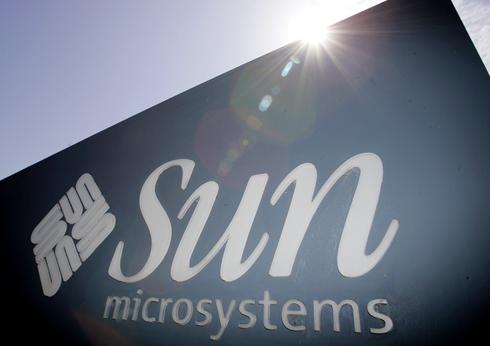USA Today

A sign in front of Sun Microsystems’ headquarters in Santa Clara, Calif. Information technology company Oracle is buying Sun Microsystems in a cash deal the company valued at $7.4 billion.
REDWOOD SHORES, Calif. (AP) — Oracle snapped up computer server and software maker Sun Microsystems for $7.4 billion Monday, pouncing on an opportunity that opened up after rival IBM Corp. abandoned an earlier bid to buy one of Silicon Valley’s best known — and most troubled — companies.
The deal will end Sun’s 27-year history as Silicon Valley‘s brash independent and give Oracle ownership of the Java programming language, which runs on more than 1 billion devices around the world. Oracle also will take charge of the Solaris operating system, which already has been a platform for much of Oracle’s products.
It’s far from Oracle’s biggest acquisition during a four-year shopping spree that has cost more than $40 billion, but it may be the boldest.
Oracle, a Redwood Shores, Calif.-based business software maker, will be branching more into storage and computer hardware as it accelerates its attempts to become a one-stop technology shop for more than 300,000 corporate, government and academic customers.
“With the acquisition of Sun, Oracle is now able to make all of the pieces of the technology stack fit together and work well,” Oracle Chief Executive Larry Ellison said during a Monday conference call.
Jonathan Schwartz, Sun’s CEO, predicted the combination will create a “systems and software powerhouse” that “redefines the industry, redrawing the boundaries that have frustrated the industry’s ability to solve.” Among other things, he predicted Oracle will be able to offer its customers simpler computing solutions at less expensive prices by drawing upon Sun’s technology.
Oracle will pay $9.50 in cash for each Sun share. The price represents a 42% premium to Sun’s closing stock price of $6.69 on Friday, and is about twice what Sun was trading for in March, before word leaked that IBM and Sun were in buyout negotiations. Net of Sun’s cash and debt, the transaction is valued at $5.6 billion, Oracle said.
IBM had offered to buy Sun for $9.40 per share, but acquisition talks fell apart this month in a disagreement over price and the extent to which IBM was willing to see the deal through an antitrust review.
Shares of Sun jumped $2.41, or 36%, to $9.10 in Monday’s early trading while Oracle shares shed $1.02, or 5.4%, to $18.04.
Oracle expects the purchase to add at least 15 cents per share to its adjusted earnings in the first year after the deal closes. The company estimated Santa Clara, Calif.-based Sun will contribute more than $1.5 billion to Oracle’s adjusted profit in the first year and more than $2 billion in the second year.
If Oracle can hit those targets, Sun would yield more profit than the combined contributions of three other major acquisitions — PeopleSoft Inc., Siebel Systems Inc. and BEA Systems — that cost Oracle a total of more than $25 billion.
Some of Oracle’s earlier acquisitions have resulted in a significant number of layoffs. In Monday’s conference call, Oracle didn’t discuss how the deal would affect jobs. Oracle employs about 86,000 people worldwide while Sun has about 33,000 workers.
Sun, which invented the Java programming language used to develop applications for websites, mobile phones and even DVD players, had been reluctant to sacrifice its independence, even as it reported big losses. Despite billions in sales — $13.3 billion over the last four quarters — the company has not been able to turn a consistent profit, losing $1.9 billion in the same period.
Analysts have long said the company can not stand on its own and many were skeptical the company would be able to find another buyer after talks with IBM broke down.
A deal with Oracle might not be plagued by the same antitrust issues, since there is significantly less overlap between the two companies. Still, Oracle could be able to use Sun’s products to enhance its own software.
Oracle’s main business is database software. Sun’s Solaris operating system is a leading platform for that software. The company also makes “middleware,” which allows business computing applications to work together. Oracle’s middleware is built on Sun’s Java language and software.
Calling Java the “single-most important software asset we have ever acquired,” Ellison predicted it would eventually help make Oracle’s middleware products generate as much revenue as its database line does.
Sun’s takeover is a reminder that a few missteps and bad timing can cause a star to come crashing down.
Sun was founded in 1982 by men who would become legendary Silicon Valley figures: Andy Bechtolsheim, a graduate student whose computer “workstation” for the Stanford University Network (SUN) led to the company’s first product; Bill Joy, whose work formed the basis for Sun’s computer operating system; and Stanford MBAs Vinod Khosla and Scott McNealy.
Sun was a pioneer in the concept of networked computing, the idea that computers could do more when lots of them were linked together. Sun’s computers took off at universities and in the government, and became part of the backbone of the early Internet. Then the 1990s boom made Sun a star. It claimed to put “the dot in dot-com,” considered buying a struggling Apple Computer Inc. and saw its market value peak around $200 billion.
But Sun was slow to react when the bottom fell out in 2001. Its high-end products, built on Sun’s proprietary systems and its own microprocessors, suffered against less-expensive rivals that used industry-standard technologies such as chips from Intel Corp. and Advanced Micro Devices Inc. and software from Microsoft. Sun lost more than $5 billion in the first five years after the bubble burst.
Copyright 2009 The Associated Press. All rights reserved

